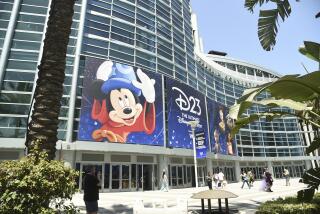Documentary : Giving Euro Disneyland a Whirl : * An American girl finds plenty of <i> joie de vivre </i> at the troubled park near Paris. Prices are another matter.
MARNE-LA-VALLEE, France — My daughter Katie gripped the controls in gloved hands and, with a cold rain spitting in our face, we soared above the gray wintry tableau of Euro Disneyland on--what else?--Dumbo the Flying Elephant.
Down below, families in matching yellow Disney rain ponchos ($4.50 at shops everywhere) gamely strolled through the puddles. Cheerful Christmas music, and the scent of popping corn and baking cookies, wafted up from Main Street U.S.A.
And, through the mist, we could see Le Chateau de la Belle au Bois Dormant, or Sleeping Beauty’s castle. And wasn’t that the Evil Queen from Blanche-Neige et les Sept Nains, Snow White and the Seven Dwarfs, watching us from one of the balconies?
Hearing my 5-year-old’s delighted giggles, as Dumbo leaped up and down at her touch, I had to admit we were having fun. Dressed in corduroy pants, woolen hats, heavy coats and rain gear, to be sure. But having a good time, just the same.
Later, climbing onto a docked pirate ship, and probably speeding from infusions of chocolate and sugar, Katie said: “People like Disney, don’t they, Dad?”
Indeed, they do. Of course, I didn’t have the heart to tell her that Michael D. Eisner, chairman of the Walt Disney Co., had only a few days earlier said Euro Disneyland might close unless European banks agreed to restructure its $3.7 billion in loans.
Disney has agreed to keep its European subsidiary, which owns 49% of the shares, afloat for three months. And Eisner is playing the kind of economic hardball that a youngster probably wouldn’t appreciate.
But the paradox of Euro Disney is that the park itself, from Thunder Mountain to Star Tours, and the Mad Hatter’s Tea Cups to the Pirates of the Caribbean, has been a success, by almost anyone’s measure. More than 18 million visitors have spun through the turnstiles since the opening in April, 1992, making it the single largest tourist attraction in France, far surpassing even the Eiffel Tower and the Louvre.
“People in Europe said it wouldn’t work. They said this wasn’t Florida. They said it was too cold. But, in fact, it works,” said Jean-Marie Gerbeaux, Euro Disney’s vice president of communications. “That was the first big challenge--to demonstrate that we could draw people. And that’s been very important to us.”
Even Le Monde, the influential daily newspaper, admitted recently that “we (French) had rather taunted this improbable transplant” of American popular culture, calling it a “cultural Chernobyl” and a “conservatory of nothingness.”
“Euro Disney provoked from the beginning a reflex of rejection among the intellectuals,” the paper noted. “And then, with time, even the most hostile have accepted it.”
Accepted it, in large part, because it boosted the region’s beleaguered economy. Euro Disney has generated tax revenue and paychecks in abundance--8,500 new permanent jobs and 46,000 other jobs linked to Disney’s existence. In fact, Euro Disney is responsible for half the new jobs created in France since its opening.
So what’s the problem?
Well, the economic recession in Europe has brought France 12% unemployment and hurt tourism everywhere. The 5,500 rooms in Disney’s six hotels had an average occupancy rate of 55% last year, well below the company’s expectations. Then a weak real estate market thwarted Disney’s plans to begin selling off some of its hotels last year.
Euro Disney suffered an operating loss of $300 million last year and took an additional $600 million one-time loss for staff cuts and pre-opening expenses. It is in debt up to Mickey’s ears and can’t make its loan payments. Now 60 creditor banks are trying to decide what to do.
Katie and I had waited and waited for a sunny day to make the first of what would be two visits to Euro Disney. When the sun appeared on New Year’s Day, we bundled up against the 42-degree temperatures and boarded the train, which takes 40 minutes from downtown Paris to the park in the eastern suburbs.
We paid the high-season rates that apply over the Christmas holidays--about $45 for adults and $30 for children--and joined more than 30,000 other “guests,” as Disney calls us.
We wandered through the park, which is laid out along the same lines as its older sibling in Anaheim, with wedges of the circular pie devoted to Discoveryland, Fantasyland, Adventureland, Frontierland and Main Street U.S.A..
Our first stop was for chocolate chip cookies at the Main Street deli, a personal favorite of Katie’s homesick Mom and Dad. Then we headed for Katie’s favorite attractions, remembered from her last visit to California’s Disneyland.
“It’s a Small World,” sponsored here by the French state telephone company, was Katie’s first choice, followed closely by Alice’s tea cups and flying Dumbo. The lines were fairly long, with waits ranging from half an hour to 90 minutes at the Big Thunder Mountain roller coaster.
The dozens of shops selling Disney goods were clogged with browsers, but there were no lines at the cash registers. Sticker shock is probably the biggest complaint about Euro Disney, which has been troubled by lower-than-expected spending inside the park.
We found the prices were steep, due in large part to a strong French franc, with stuffed animals beginning at about $30. We dropped $60 for two skull-and-crossbones pirate hats, a plastic dagger and a pirate pistol for Katie and her younger brother.
Then we went in search of lunch. Several of the restaurants were closed so we chose a Tex-Mex joint, Fuente del Oro Restaurante. I was disappointed to see the restaurant’s fajita bar closed and no evidence of the advertised “live mariachi music.”
“This chili is really good!” Katie said. It had better be, I responded, at $6.50 for a tiny bowl.
We ended our first day in the park by watching “C’est Magique , “ a live musical program, with young dancers and all the Disney characters switching easily from English to French and back again.
A few days later, we were back, this time in a driving, cold rain. Only a few thousand hardy souls joined us. Gone were the long lines. Gone, too, was much of the sparkle. This was a weekday in January, the start of the low season, and the winter rates were reduced to $30 per adult and $22 per child. (Seasonal fares, a first for Disney, were introduced last fall to cope with what Disney officials call “high seasonality,” a euphemism for cruddy winter weather.)
Katie took in the Aladdin parade down Main Street, with Aladdin and Jasmine waving from beneath an umbrella. An assortment of characters, from Mickey and Minnie to Tweedledum and Tweedledee, prowled the park’s covered areas in what seemed to me to be a desperate search for children to amuse. In the empty lobby of the Disneyland Hotel, Minnie Mouse used me as a shield to play hide and seek with Katie for nearly 10 minutes, until I finally escaped.
Gerbeaux met us there to talk about the park’s successes and failures, the latter of which have become daily fare for the French press. (Philippe Bourguignon, the Frenchman who took over as chairman of Euro Disney last April, isn’t doing interviews during the financial talks.)
Euro Disney has shelved the original grand plans for a second-stage expansion, and it cut 950 mostly administrative jobs last month. But construction is still under way in the park, and several new attractions will be added this summer.
The company is hoping for an increase in visitors when a new Euro Disney station for France’s high-speed train line is opened in May, cutting travel times to the park from all over continental Europe. The opening of the Channel Tunnel later this year will cut the trip from London to the park to just three hours.
In the meantime, Disney “imagineers” have been tinkering with the park, conducting thousands of exit interviews. “Euro Disney has to adapt,” Gerbeaux explained. Among the changes made last year was reducing the size of the four sit-down restaurants, increasing the seating at the fast-food places and adding wine--a first for Disney--to some menus.
“We thought, because we were in Paris and Europe, we needed more seated restaurants,” Gerbeaux said. “But, in fact, when French people come to the park they don’t spend hours at lunch.”
As for the wine, “everybody thought we added wine because of the French,” who account for 45% of the visitors, Gerbeaux said. “In fact, it was much more the non-French Europeans. The French come for the American experience. They want to drink a Coke and eat a hamburger.”
Some prices also have come down. The lowest-price meals have been cut to about $8, from $12, and even a cup of coffee costs less, $1 instead of $2. One of the park’s six hotels now offers $52-a-night double rooms for a family of four during the winter. However, the premier facility, the Disneyland Hotel, still runs $250 a night for a family of four in the low season.
Beyond that, Gerbeaux said, the chairman wants to change the Disneyland concept, to make it, well, less American. “Euro Disney should become, not French or European, but it must have its own personality,” he said. “Of course, we must stay very, very Disney. But we want people to feel at ease.”
In the lobby of the Disneyland Hotel, Katie and I found Christopher Jordan, his wife, Lulu, and their three children hiding from the rain. They had come from England for a three-day visit.
“The weather? Oh that. It’s fine,” Christopher Jordan said. But he complained about the costs. “We came with money to spend, but we didn’t spend as much as we would have because it felt like daylight robbery,” he said. “Don’t get me wrong. The place is beautiful, and we’ve enjoyed ourselves.”
Of course, those price tags don’t mean much to children. And kids aren’t dissuaded either by the inclement weather. For them, the Disney magic still exists in Marne-la-Vallee.
At 6 p.m., as the park closed, Katie and I left the Disneyland Hotel, rain-soaked but smiling. “This was great,” Katie said. “You know, Dad, if we lived in this hotel, everytime we went outside we’d be in Disneyland.”
More to Read
Sign up for The Wild
We’ll help you find the best places to hike, bike and run, as well as the perfect silent spots for meditation and yoga.
You may occasionally receive promotional content from the Los Angeles Times.







